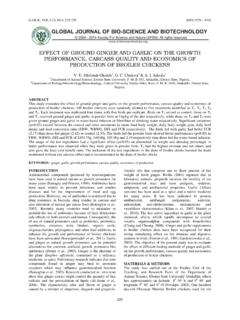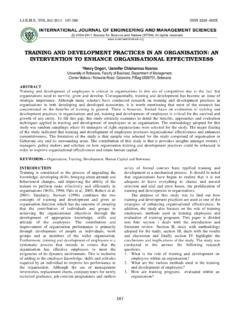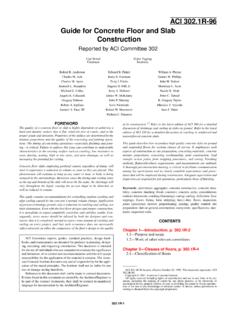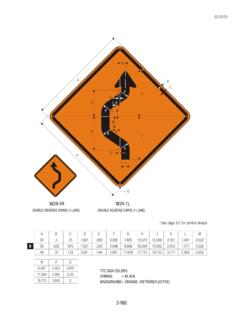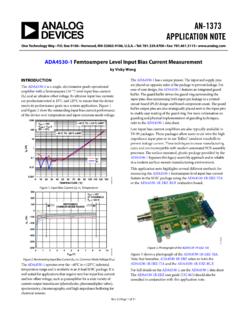Transcription of Review Article A1 AND A2 MILK & ITS IMPACT ON …
1 , (1) 2016: 01-05 ISSN 2229 6441. Review Article A1 AND A2 MILK & ITS IMPACT ON human health . 1. Prasanta Boro, 2 Binoy Chandra Naha, 3 Deep Prakash Saikia & 4 Chandra Prakash ICAR-Indian Veterinary Research Institute, Izatnagar, Bareilly, 1. PhD Scholar, LPM Section, ICAR-IVRI. 2. PhD Scholar, Animal Genetics Division, ICAR-IVRI. 3. PhD Scholar, Veterinary Biotechnology Division, ICAR-IVRI. 4. MVSc Scholar, Animal Genetics Division, ICAR-IVRI. *Corresponding author email: ABSTRACT. Most common economically important milk constituents traits include fat, protein, SNF, lactose and ash. These characteristics and associated benefits have made milk an important part of the diet.
2 Amongst the milk constituents, beta- casein has gained importance and popularity amongst the health conscious people due to its recent health related issues. Beta casein composition of milk and milk products has become an important economic trait of dairy animals. Our indigenous dairy animals produce A2 milk and India is endowed with rich A2 dairy animals since our civilizations, protecting the masses from ill effects of A1 milk. It is a matter of great concern for the health of people in India. There is a urgent need to go through our breeding policies to stop producing A1 milk. KEYWORDS: A1 and A2 Milk, human health INTRODUCTION encoding beta-casein was changed such that the 67th Milk is the complete food for the infant.
3 It contains the amino acid in the 209 amino proteins was switched from essential micro-nutrients needed for growth and proline to histidine. This new kind of beta-casein that was development of human health as well as for the neonate created is known as A1 beta-casein which is found in the animal. In USA, Australia, New Zealand and other milk of many crossbred cows such as Holstein, jersey and developed countries, people use to consume milk Friesian. according to their needs and use milk like A2 milk, since Basic genetics of A1 and A2 milk A2 milk is harmless whereas A1 milk is harmful for The A1/A2 status of a cow is determined by a pair of health .
4 So, our future breeding policies for dairy animals genes on the sixth chromosome (Rijnkels, 2002). There should be done in a systematic manner, keeping an eye on are two major alleles of the gene A1 and A2 beta- producing clean and healthy milk which is none other than casein alleles. A cow carries two copies of the beta-casein A2 Milk. gene; she can carry either of A2A2 (homozygous), A1A2. What actually is A1 and A2 milk? (heterozygous) or A1A1 (homozygous) alleles. Neither Milk contains about 85% water. The remaining 15% is the allele is dominant over the other rather; they are co- milk sugar lactose, protein, fat and minerals. Beta-casein is dominant additive in their effect.
5 Therefore, an A1A2. about 30% of the total protein content in milk. A2 milk is cow will produce A1 and A2 beta-casein in equal the milk that contains only the A2 type of beta-casein amounts. An A2A2 cow will only produce A2 beta-casein protein whereas A1 milk contains only A1 beta casein or and an A1A1 cow will only produce A1 beta-casein. The A1A2 type variant. A1 protein variant is commonly found Northern European breeds of cows such as the Friesian in milk from crossbred and European breeds of cattle. A2 and Holstein carry the A1 and A2 allele at about equal milk is found basically in indigenous cows and buffaloes levels. The Southern European breeds and the Jersey carry of India (Asia as a whole).
6 A2 milk is branded by the A2 the A1 allele at about 35% and 2/3 of A2. Exceptionally, Milk Company like A2 Corporation and sold mostly in Guernsey breed appears to carry the A1 allele at less than Australia, New Zealand, United Kingdom and other 10% and the Scottish Ayrshire breed appears to be well developed countries. over 50%. In addition, individual herds may carry the History of A1 and A2 Milk allele at levels that are quite different to the average for the A2 beta-casein is the beta-casein from cows that have been breed. If a cow is A2A2 then she is guaranteed to pass on produced since before they were first domesticated over the A2 allele to her progeny.
7 Similarly, an A1 cow is 10,000 years ago. It has no known negative effects on guaranteed to pass on the A1 allele. For an A1A2 cow human health . In the past few thousand years, a natural there is a 50% chance of passing on either of the allele. mutation occurred which has resulted in a proportion of cows of European breeds producing a casein variant called Status of Milk protein variants in Cattle A1 beta-casein. Slowly, these protein variant became Researches conducted on indigenous cows (Zebu type), dominant in milk which producing A1 milk. The gene buffaloes and exotic cows (Taurine type) have revealed 1. A1 and A2 Milk: Its IMPACT on human health that A1 allele is more frequent in exotic cattle (A1 milk) used for farming, is around 94 per cent (Joshi, 2011) and while Indian native dairy cows and buffaloes have only A2 while in foreign breeds (HF and Jersey), it is around 60.
8 Allele and hence are a source for safe milk A2 milk per cent (NBAGR, 2011). A1 -casein is absent in the (Mishra et al., 2009). The A2 allele gene in Indian milk milk of pure Asian and African Cattle (Ng-Kwai-Hang breeds of cows and buffaloes are 100% (Red Sindhi, and Grosclaude, 2002). So, our indigenous cows and Sahiwal, Tharparkar, Gir and Rathi), other Indian breeds buffaloes produce A2 milk. 1. Allelic and genotypic frequency of Beta casein gene across the Indian cattle breeds (Mishra et al., 2009). Sl. No. Cattle breeds Allelic Frequency Genotype Frequency A1 A2 A1A1 A1A2 A2A2. 1 Sahiwal 0 1 0 0 1. 2 Red Sindhi 0 1 0 0 1. 3 Tharparkar 0 1 0 0 1.
9 4 Gir 0 1 0 0 1. 5 Kangayam 0 1 0 0 1. 6 Nimari 0 1 0 0 1. 7 Red Kandhari 0 1 0 0 1. 8 Amritmahal 0 1 0 0 1. 9 Malvi 0 1 0 0 1. 10 Kankrej 0 1 0 0 1. 11 Hariana 0 1 0 0 1. 12 Rathi 0 1 0 0 1. 13 Mewati 0 1 0 0 1. 14 Malnad Gidda 0 15 Kherigarh 0 2. Occurance of Beta casein gene variants in various cattle breeds and countries (Kaminiski et al., 2007). Sl. No. Cattle breeds Countries Frequency of Beta casein alleles References B A1 A2. 1 Jersey Germany Ehrmann et al., 1997. Denmark Bech et al., 1990. New Zealand - Winkelman and Wickham, 1997. USA Enennam et al.,1991. 2 HF Norway - Lien et al., 1993. 3 Guernsey USA Swaissgood, 1992. 4.
10 Brown Swedish Germany Ehrmann et al., 1997. 5. Simmental Croatia Curik et al.,1997. 6 Ayrshire UK Swaissgood, 1992. 3. Allelic and genotypic frequency of Beta casein gene across the Indian Buffalo breeds (Mishra et al., 2009). Sl. No. Buffalo breeds Allelic Frequency Genotype Frequency A1 A2 A1A1 A1A2 A2A2. 1 Murrah 0 1 0 0 1. 2 Mehsana 0 1 0 0 1. 3 Marathwada 0 1 0 0 1. 4 South Kanara 0 1 0 0 1. 5 Manipuri 0 1 0 0 1. 6 Assamese Swamp 0 1 0 0 1. 7 Nilli-Ravi 0 1 0 0 1. 8 Pandharpuri 0 1 0 0 1. Milk protein and BCMs milk casein is composed of primarily , and 1. -casein Bovine milk protein is composed approximately of 80% is the second most abundant protein and crucial for casein casein and 20% whey (Shah, 2000; Niki et al.)
